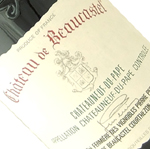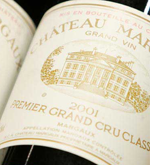Vintage 2010 Burgundy white 12 Jan 2012
White Burgundy 2010: Sarah Marsh MW
- Thursday 12 January 2012
- by Sarah Marsh MW
- Comments
It's a tiny crop and prices are likely to be high, but that's unlikely to halt the rush for these wines, says Sarah Marsh MW, who praises their generosity, concentration, vigour and refreshingly light alcohols.
Lovers of proper white Burgundy should not hesitate to snap up the 2010 vintage. The style is more classically Burgundian than 2009, driven by firm acidity, but also ripe. This equitable profile will hold much appeal, but there is precious little of it. It is a tiny harvest due to poor flowering, although this meagre crop was a blessing given the shortage of sun to ripen a more generous one. The quality, based on my tastings at 40 domaines and the top seven négociants (700+ wines in total), is excellent, with the caveat that it will not be as consistent as in 2009 – a year in which it was hard to make bad wine. 2010 could have been an average year, given the mediocre summer, but with the intensity achieved via small yields, it has blossomed into a very good one. The best wines are better and more interesting than in 2009.
Energetic and elegant
Expect price increases for the 2010s. With yields down 15% to 30% – and for some as much as 50% – prices from the domaines will have to reflect this. Négociants may be able to absorb some of the 15% to 20% increase in fruit prices. Nevertheless, bite the bullet and buy white Burgundy 2010 – even if you have lots of the 2009s. It will provide a refreshing contrast to that more extrovert vintage. After a slightly miserable summer, September 2010 brought storms. Santenay was devastated by hail. Humidity and lightning turned some nearripe Chardonnay brown overnight. This tended to be in the warmer, better places – the premier cru vineyards on the mid slope. Many rushed to harvest from mid-September, especially in Meursault, worried by the onset of botrytis. Others waited. On the whole, the fruit was healthy and it was possible to wait – the acidity was high and the weather held, so the grapes continued to ripen well. As is often the case, September saved the vintage.
The small berries had good concentration: less sugar than in 2009 and more acidity. The style is fresh but succulent; in the same family as 2004, 2007 and 2008. But it has more fruity generosity than the ’07s and ’04s and is not as straight as ’08. There is much to like here. It is energetic, with more vigour than 2009, but less than ’08. ‘It has the 2007 elegance, and the 2008 density, but without the weight,’ says Dominique Lafon. The style will vary, however, as grape maturation was erratic, differing markedly in neighbouring parcels. There is some botrytis, although the top growers generally removed any affected berries.
High expression, low alcohol
The wines are not heavy, with most coming in at under 13.5% alcohol, and some as low as 12.2%. It is very pleasing to see some grands crus around 13%: these fine wines have marvellous dimension without large proportions. Domaine Leflaive and Michel Morey-Coffinet accomplish this even with Bâtard-Montrachet – not an easy grand cru to make without weight. As for the other grands crus, 2010 has yielded wonderfully refined Chevalier- Montrachet and profound Le Montrachet in which the emphasis is on superb intensity of fruit, rather than concentration.
It is the fourth year in a row for good terroir expression. ‘2010 is a vintage with high aromatic precision and good acidity,’ says Eric Rémy at Domaine Leflaive. ‘There is very good definition of each terroir as we saw in 2007 and 2008.’ There is clarity and perhaps more immediate transparency to the terroir than in the riper 2009. The aromatic precision is not confined to the nose, but includes the scent on the palate as well.
2010 may take more time and can be tucked away in the cellar for a while – at least four to six years for the premiers crus – and it has good ageing potential beyond this. If one wanted to leave the wines to drink nearer their peak, it would be worth laying down the top village wine for eight years; the premiers crus for 10 to 12 years; and the grands crus from 12 to 20 years for the best.
Energetic and elegant
Expect price increases for the 2010s. With yields down 15% to 30% – and for some as much as 50% – prices from the domaines will have to reflect this. Négociants may be able to absorb some of the 15% to 20% increase in fruit prices. Nevertheless, bite the bullet and buy white Burgundy 2010 – even if you have lots of the 2009s. It will provide a refreshing contrast to that more extrovert vintage. After a slightly miserable summer, September 2010 brought storms. Santenay was devastated by hail. Humidity and lightning turned some nearripe Chardonnay brown overnight. This tended to be in the warmer, better places – the premier cru vineyards on the mid slope. Many rushed to harvest from mid-September, especially in Meursault, worried by the onset of botrytis. Others waited. On the whole, the fruit was healthy and it was possible to wait – the acidity was high and the weather held, so the grapes continued to ripen well. As is often the case, September saved the vintage.
The small berries had good concentration: less sugar than in 2009 and more acidity. The style is fresh but succulent; in the same family as 2004, 2007 and 2008. But it has more fruity generosity than the ’07s and ’04s and is not as straight as ’08. There is much to like here. It is energetic, with more vigour than 2009, but less than ’08. ‘It has the 2007 elegance, and the 2008 density, but without the weight,’ says Dominique Lafon. The style will vary, however, as grape maturation was erratic, differing markedly in neighbouring parcels. There is some botrytis, although the top growers generally removed any affected berries.
High expression, low alcohol
The wines are not heavy, with most coming in at under 13.5% alcohol, and some as low as 12.2%. It is very pleasing to see some grands crus around 13%: these fine wines have marvellous dimension without large proportions. Domaine Leflaive and Michel Morey-Coffinet accomplish this even with Bâtard-Montrachet – not an easy grand cru to make without weight. As for the other grands crus, 2010 has yielded wonderfully refined Chevalier- Montrachet and profound Le Montrachet in which the emphasis is on superb intensity of fruit, rather than concentration.
It is the fourth year in a row for good terroir expression. ‘2010 is a vintage with high aromatic precision and good acidity,’ says Eric Rémy at Domaine Leflaive. ‘There is very good definition of each terroir as we saw in 2007 and 2008.’ There is clarity and perhaps more immediate transparency to the terroir than in the riper 2009. The aromatic precision is not confined to the nose, but includes the scent on the palate as well.
2010 may take more time and can be tucked away in the cellar for a while – at least four to six years for the premiers crus – and it has good ageing potential beyond this. If one wanted to leave the wines to drink nearer their peak, it would be worth laying down the top village wine for eight years; the premiers crus for 10 to 12 years; and the grands crus from 12 to 20 years for the best.










